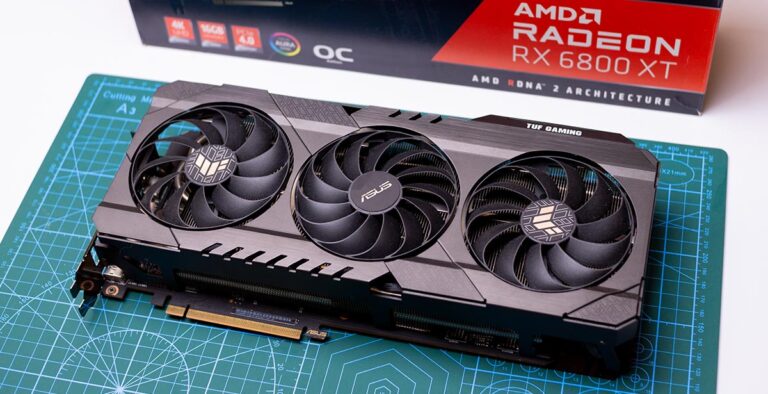
The ASUS TUF Gaming Radeon RX 6800 XT is ASUS’ take on the AMD Radeon RX 6800 XT. It has a better build, higher-rated clock speeds, and a significantly beefed-up cooling solution. It is being positioned as an upper midrange card designed for 1440p gaming and is more affordable than the premium ROG lineup to become more appealing to the mainstream crowd.
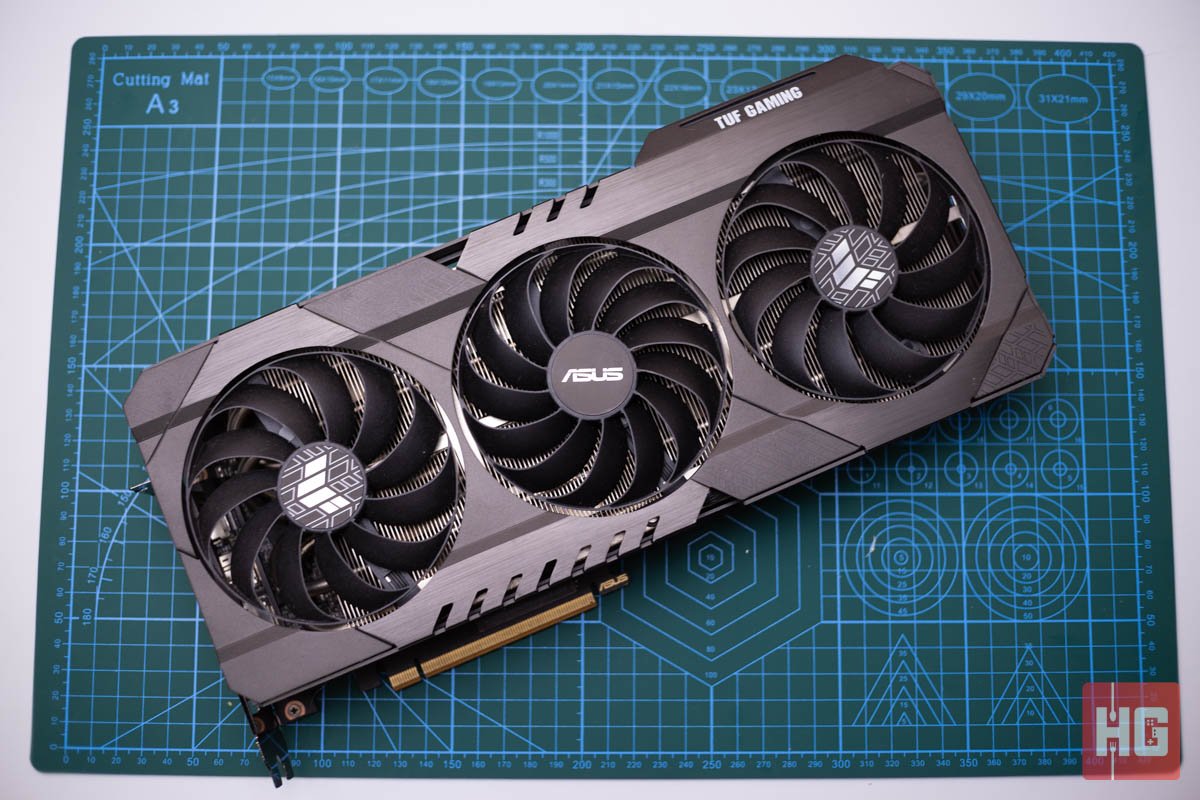
| GPU | Navi 21 XT |
| Architecture | RDNA2 |
| Manufacturing Process | 7nm TSMC |
| Clock Speeds | OC Mode: Up to 2340MHz (Boost), Up to 2090MHz (Gaming), Gaming Mode: Up to 2310MHz (Boost), 2065MHz (Gaming) |
| Stream Processors | 2560 |
| Compute Units | 40 |
| Ray Accelerators | 72 |
| Memory | 16GB GDDR6 |
| Memory Bus | 256-bit |
| Infinity Cache | 128MB |
| TDP | 300W |
| Cooling | ASUS Axial-Tech Fans |
| Power Connectors | 2x 8-Pin PCIe |
| Display Connections | 3x DisplayPort 1.4a, 1x HDMI 2.1 |
| Dimensions | 320 x 140.2 x 57.8mm |
| RGB Lighting | Aura Sync, ARGB |
| Extras | Aluminum Backplate |
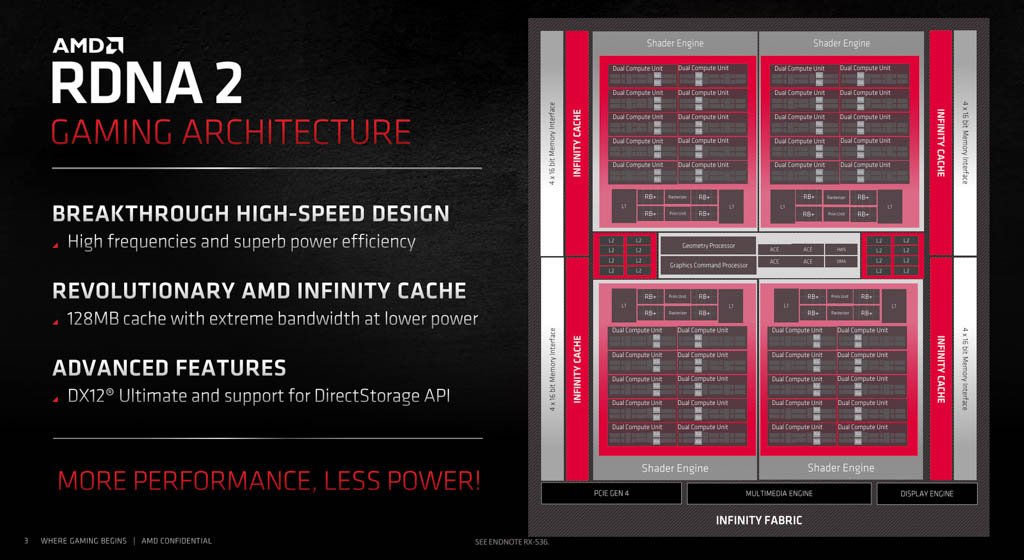
AMD’s RDNA2 architecture, also known as Big Navi, is essentially the next evolution of RDNA introduced with the Radeon 5000 series. It still uses a 7nm lithography while becoming more efficient than its predecessor. Their new generation GPUs are also boasting GPU clock speeds well beyond the 2000MHz mark, which should deliver faster performance across the board.

Overall, AMD is promising up to 54% gain in performance-per-watt thanks to clock enhancement, frequency increase, and varying optimizations. In the case of the RX 6800, AMD has shaved a bit of processing power to separate itself from its XT variant. Due to this, it has also been positioned at a slightly lower SRP of USD 579.

One of the solutions that AMD implemented on RDNA2 is the usage of the Infinity Cache. Not to be confused with the Infinity Fabric found on their CPUs, Infinity Cache uses a 128MB cache on the die itself in order to bridge the size between of the VRAM and the traditional L2 cache found on GPUs. This allows for better bandwidth, lower latency, and faster memory access.
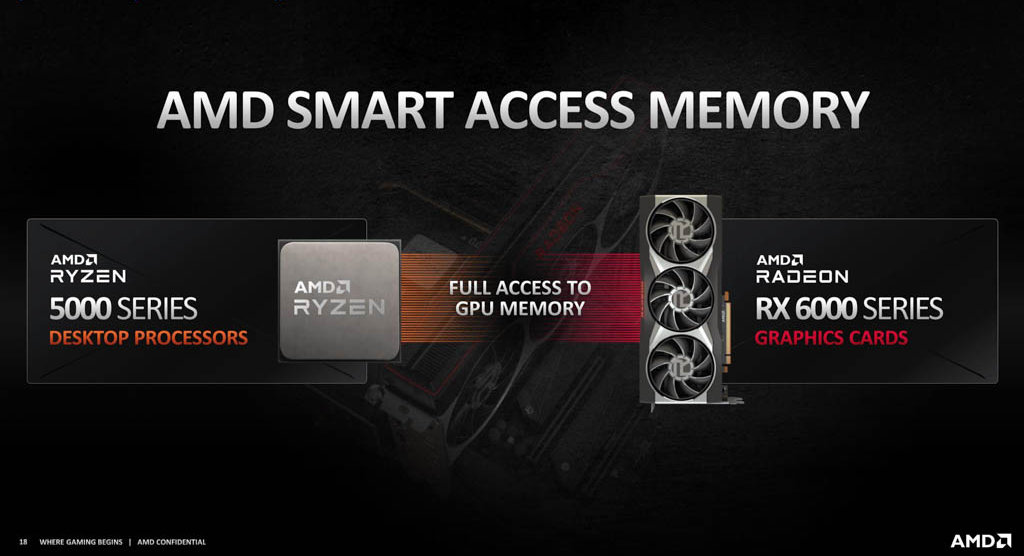
Transfers between the CPU and GPU are normally limited to a 256GB chunk. AMD’s Smart Access Memory (SAM) combines the memory of the CPU and GPU to increase that limit to reduce buffering and latency. AMD claims that SAM provides up to 10% of additional framerate to games but this increase is much more noticeable to higher resolutions.
At this time, this feature is only compatible between the RX 6000 series GPUs and Ryzen 5000 series processors on X570 boards. AMD, however, is working hard to have it compatible with NVIDIA and Intel platforms.
Big Navi will officially support ray tracing in games albeit in a lesser extent compared to the competition’s latest offerings. AMD is implementing dedicated RT cores on RDNA2-based GPUs in order to improve performance of ray tracing effects
Fidelity FX Super Resolution, otherwise known as FSR, is AMD’s answer to NVIDIA’s DLSS technology. It lowers the render resolution of games to improve performance and then upscales the image to the target resolution using algorithms to put the quality almost on-par to the native resolution.
The FSR upscaling algorithm analyzes the source image at the anti-aliased input resolution and then recreates it at the target resolution. A sharpening pass improves the image quality by enhancing texture detail.

The result is an upscaled image with higher quality details compared to basic point or bilinear upscaling. AMD says that image quality is near-indistinguishable at Ultra Quality mode while performance in games is increased by up to 2.4x at 4K at Performance Mode. At this time, FSR is supported by around 50 games and engines including Deathloop, Far Cry 6, Godfall, DoTA 2, and more games are on the way.
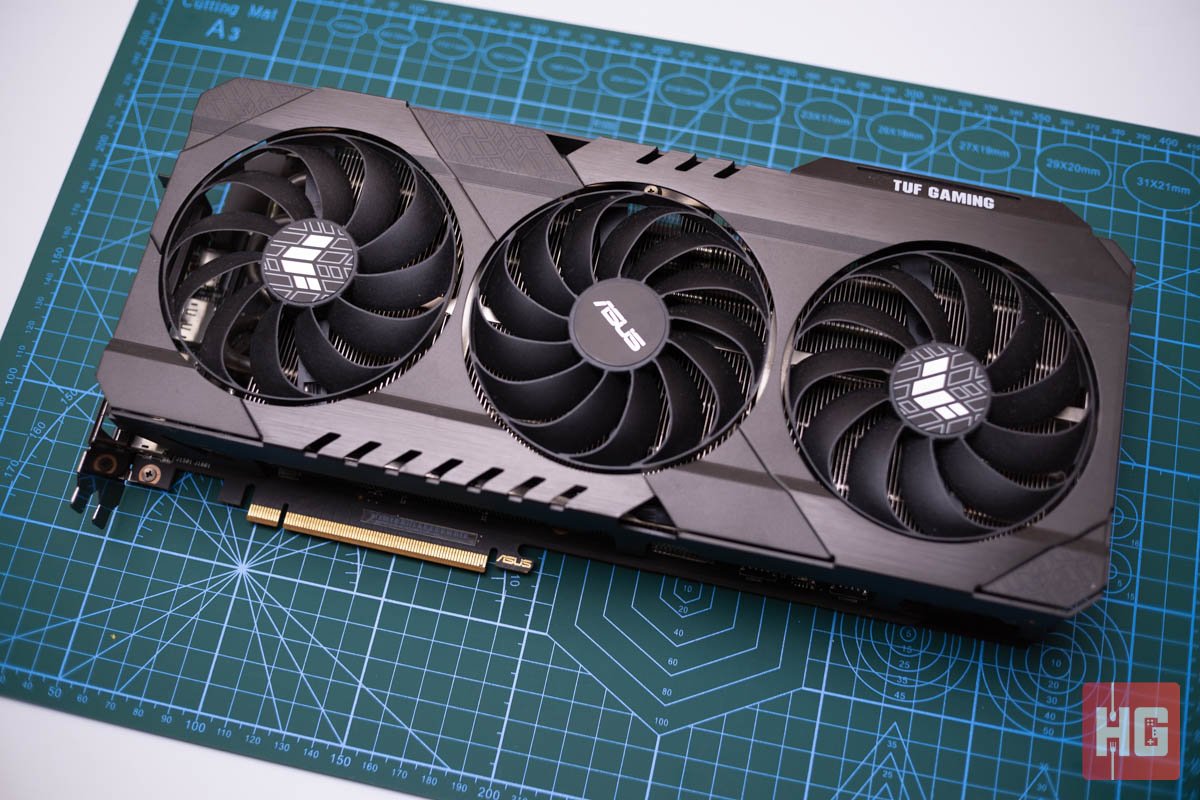
ASUS TUF Gaming Radeon RX 6800 XT shares the same design as other TUF Gaming series cards even NVIDIA-based cards like the ASUS TUF Gaming RTX 3080. It is a thick card measuring 320 x 140.2 x 57.8mm and requires nearly 3 slots on your PCIe expansion slots. So those who are building small ITX systems may want to watch out for space requirements.
Most of its body is made out of aluminum including the shroud, which makes the card heavier budget-friendly cards in the market. Three Axial-tech fans with dual ball bearings and extra blades cool the card. The center fan spins counter to the other two in order to reduce turbulence while the fans’ outer ring increase static pressure for better cooling performance. Cooling is further enhanced by its massive heatsink that draws away heat from its internal components.
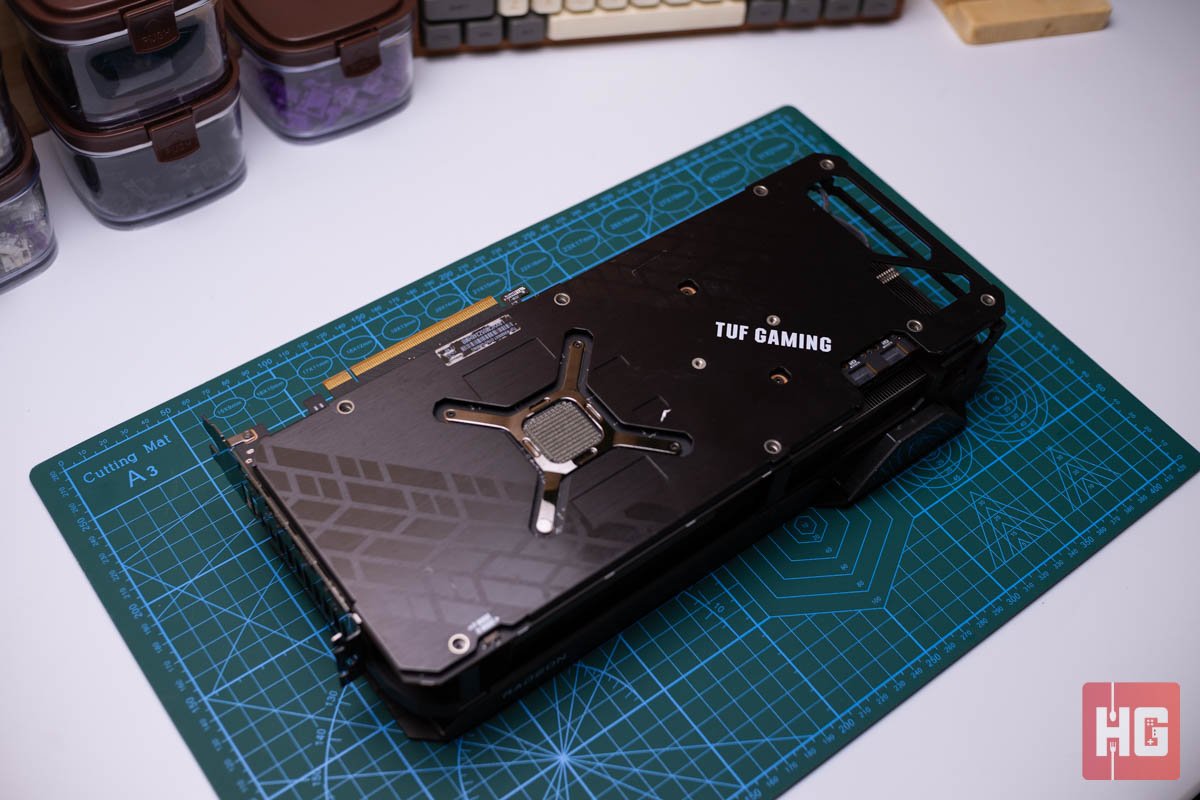
The backplate is also made out of aluminum. It does provide some passive cooling on the components located at the other side as well as needed rigidity to the card so the PCB won’t flex as much if mounted horizontally.
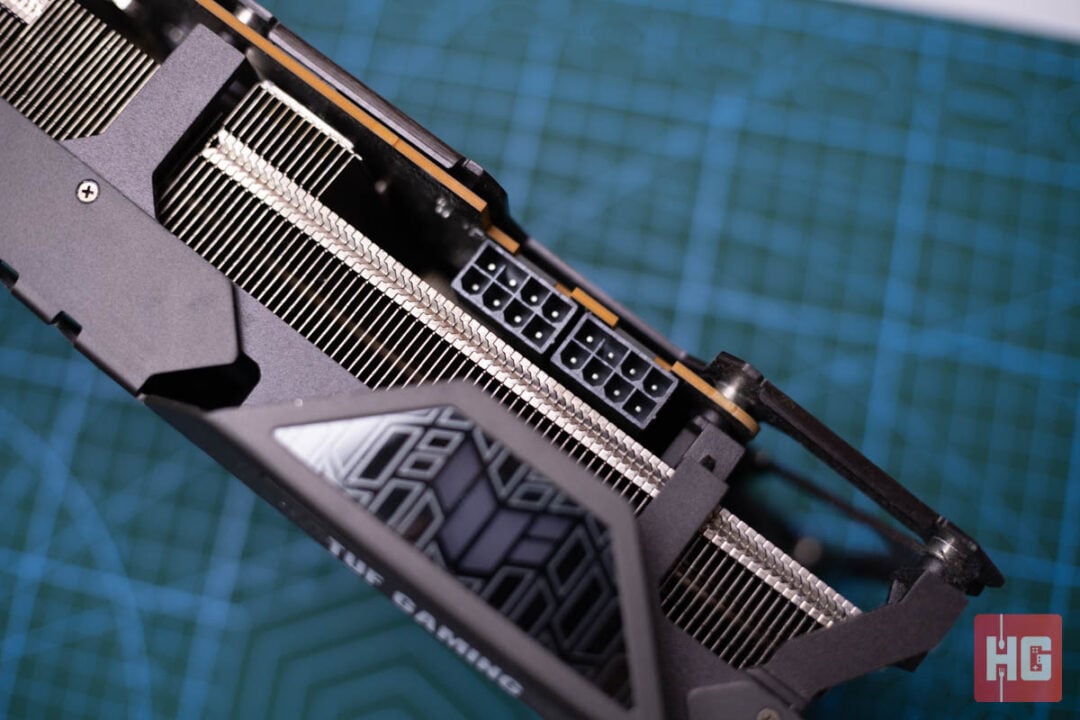

The Radeon RX 6800 XT is rated at a TDP of 300W. Power is delivered through two 8-pin PCIe connectors at the side. Over at the back are four display connections – three DisplayPort 1.4a connectors and a single HDMI 2.1 port.
The card supports RGB lighting but is only limited through the TUF Gaming logo at the side. It can be synchronized via ASUS AURA SYNC alongside with other compatible devices for themed builds.

The ASUS TUF Gaming Radeon RX 6800 XT will be tested using various synthetic benchmarks and games using differing APIs including DX11, DX12, and Vulkan at three mainstream resolutions – 1920 x 1080, 2560 x 1440, and 3840 x 2160 – to get an idea on how it would perform in various scenarios. Vendor-exclusive features like DLSS, FSR, Hairworks, and the like will the turned off to maintain parity among the cards.
The card was tested with these components:


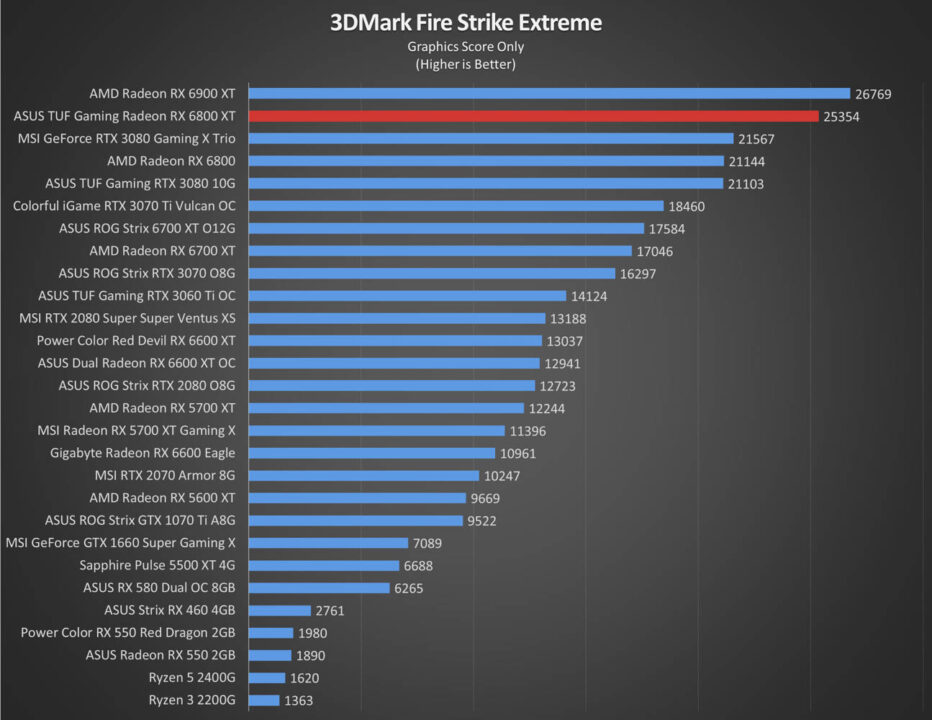


The RX 6800 XT has spectacular rasterization performance on 3DMark Fire Strike and Time Spy. The card is able to place near the top as expected from a card of its caliber. Synthetic ray tracing performance, however, leaves a lot to be desired. These are the first cards that AMD shipped with ray tracing support and it shows. It is placing a tier below where its price point suggests nearly equaling the performance of the RTX 3070.
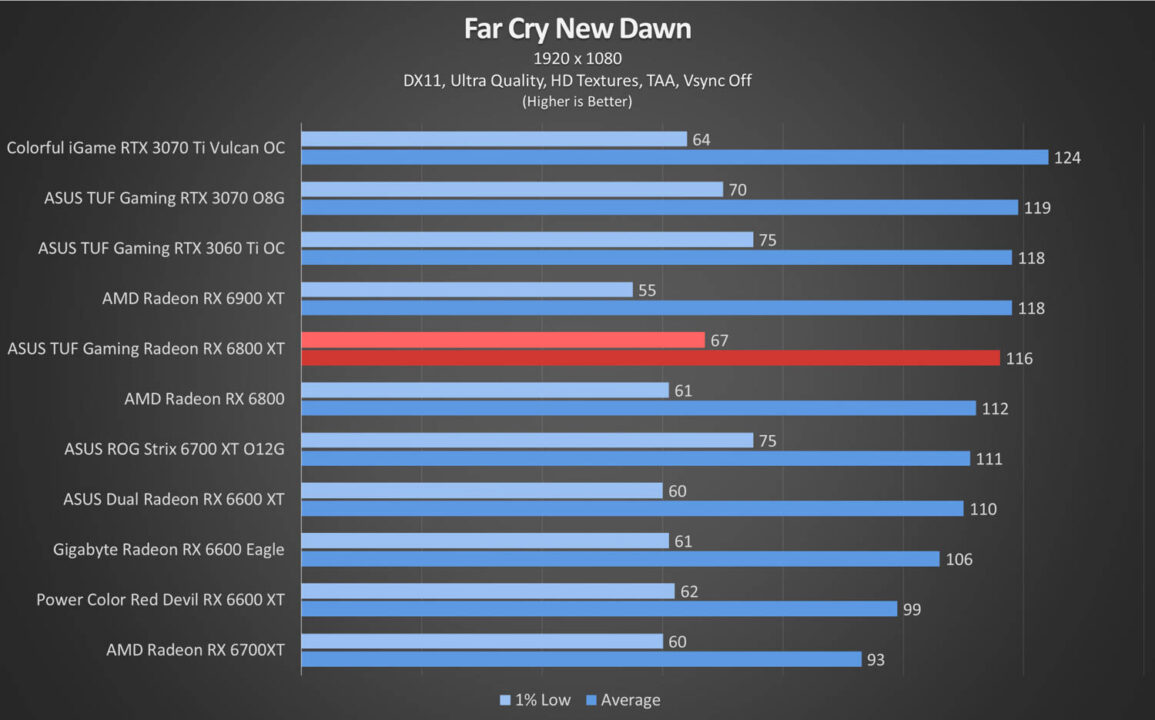
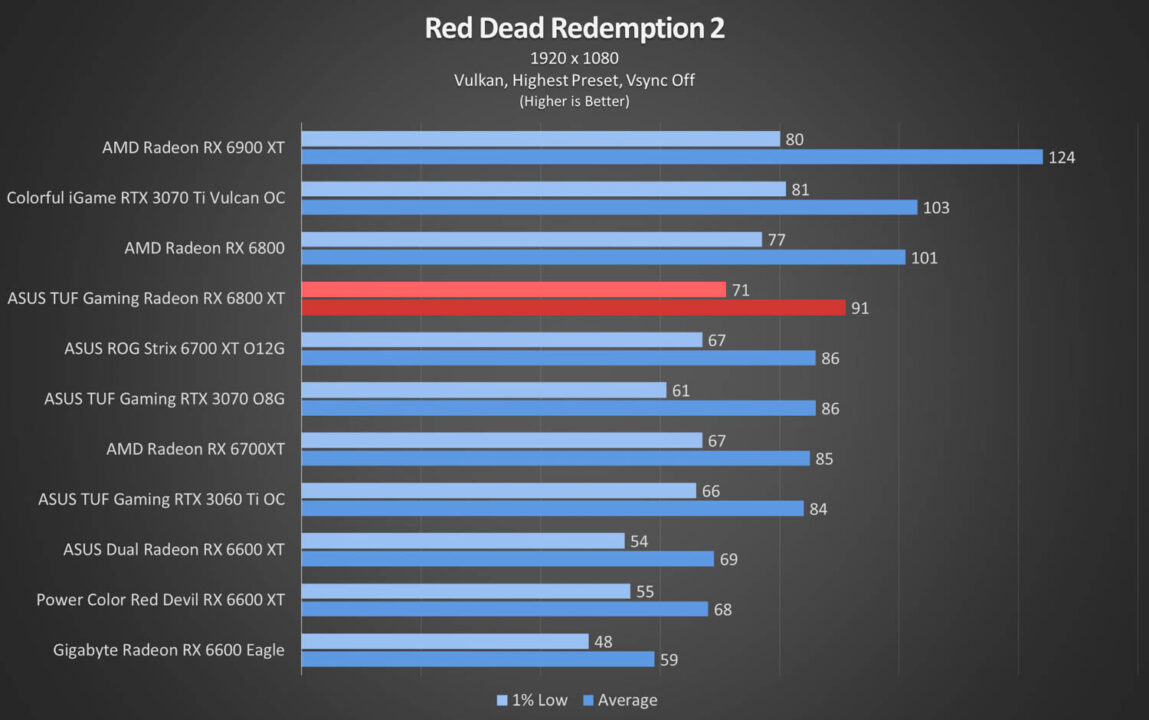
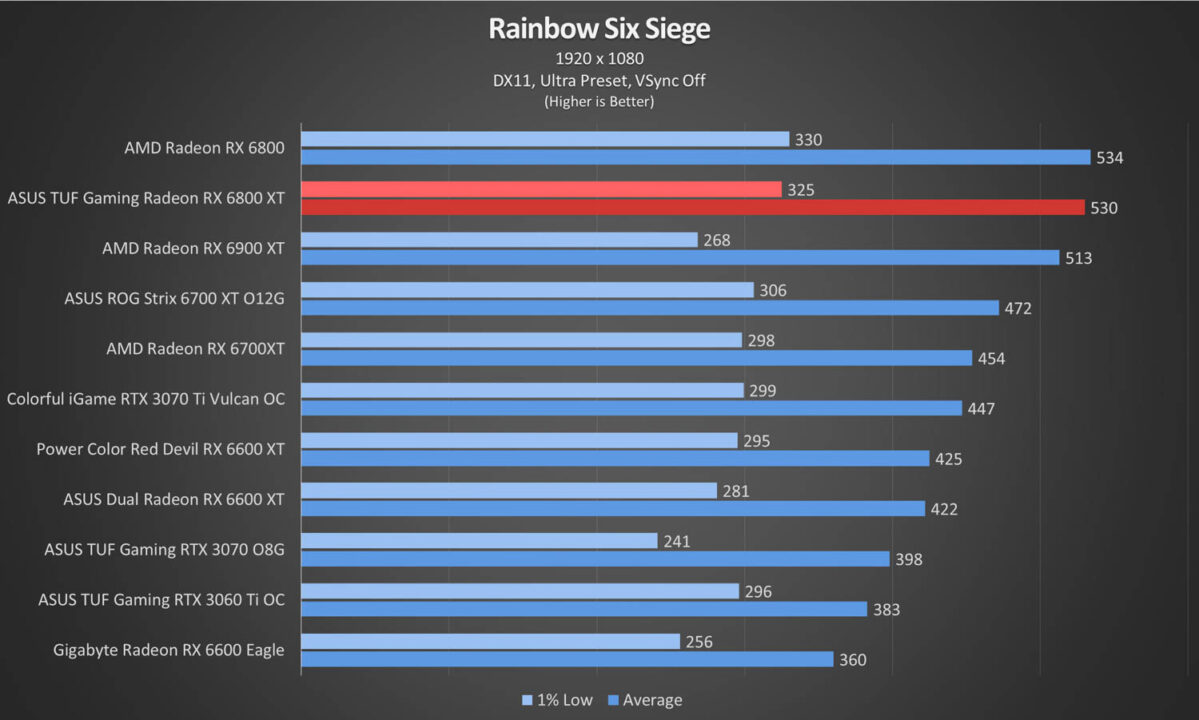
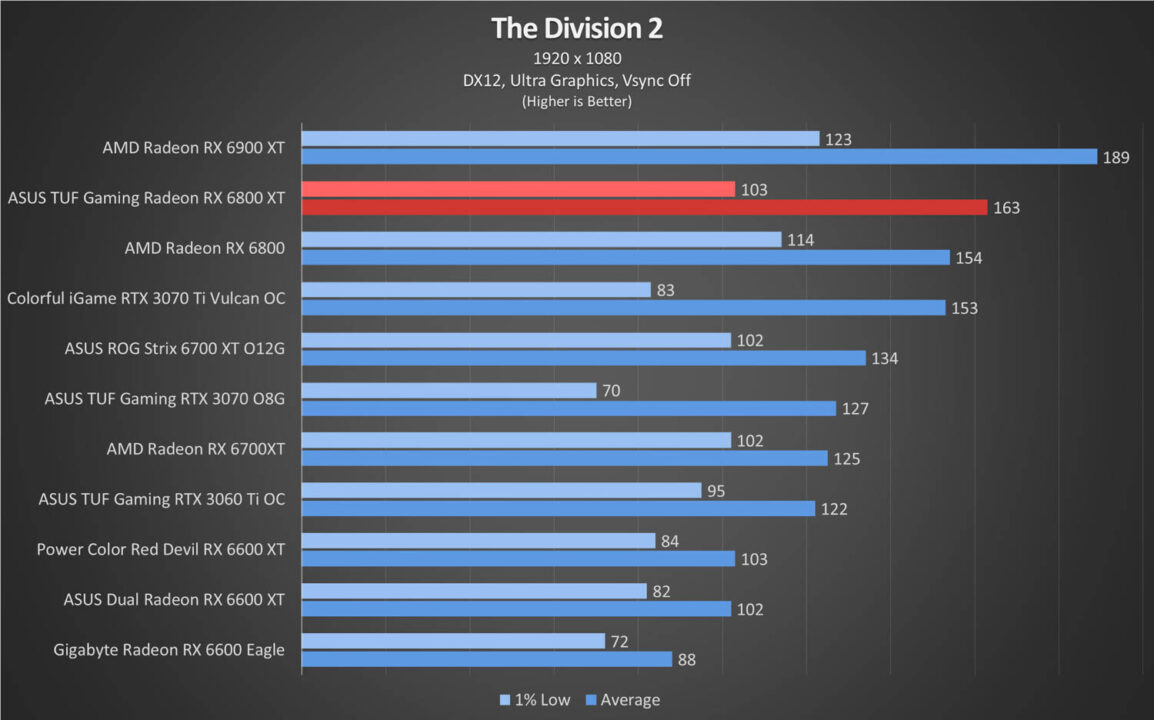
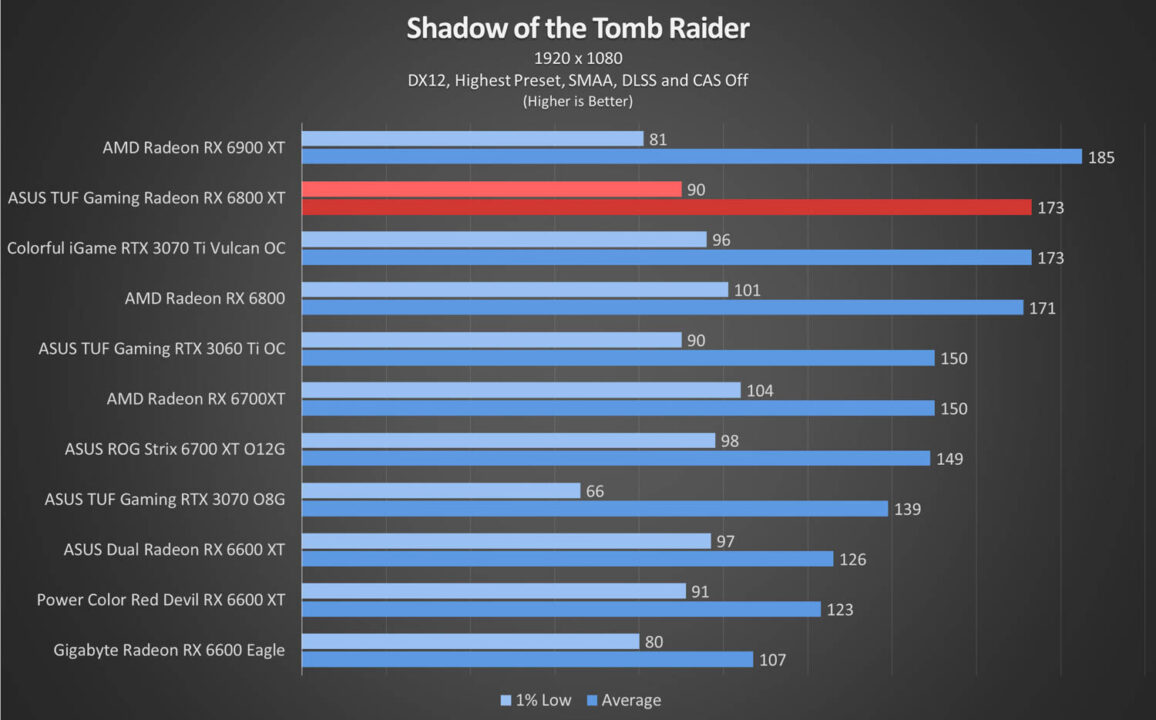
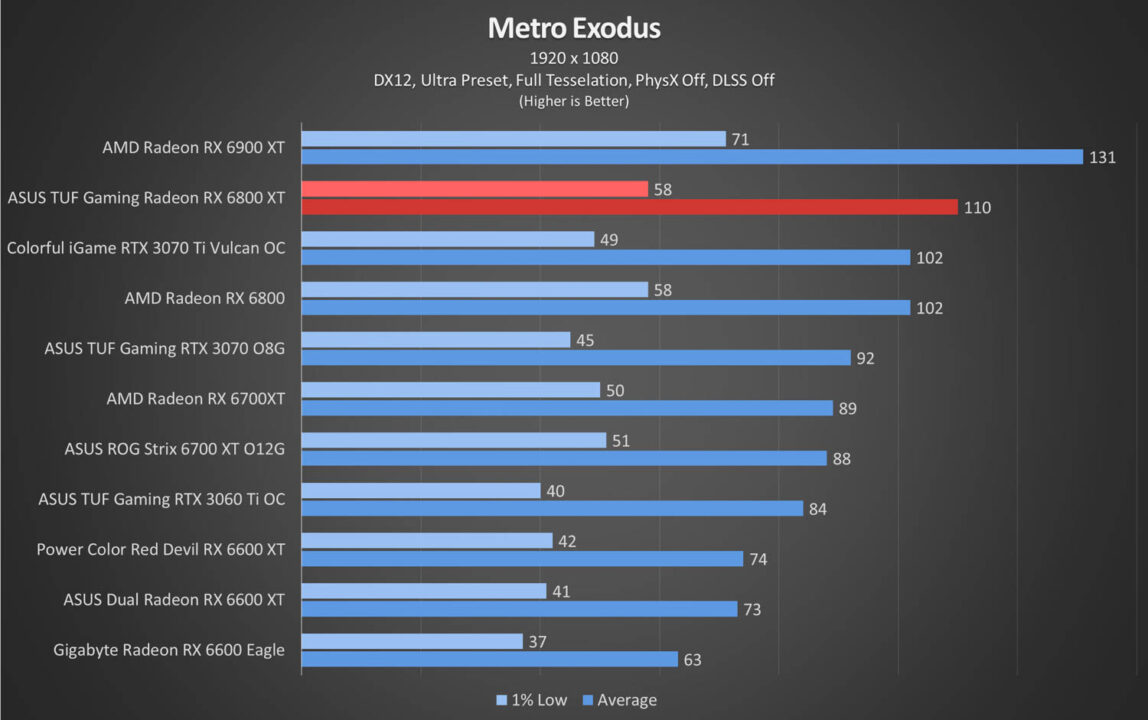
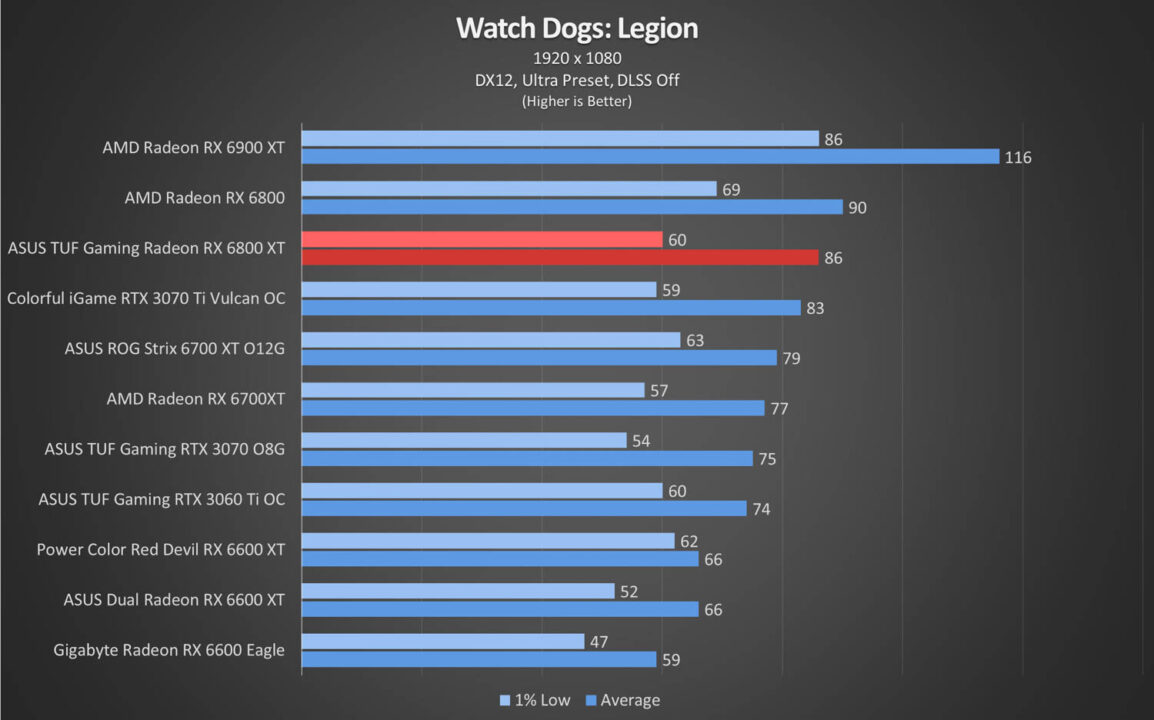
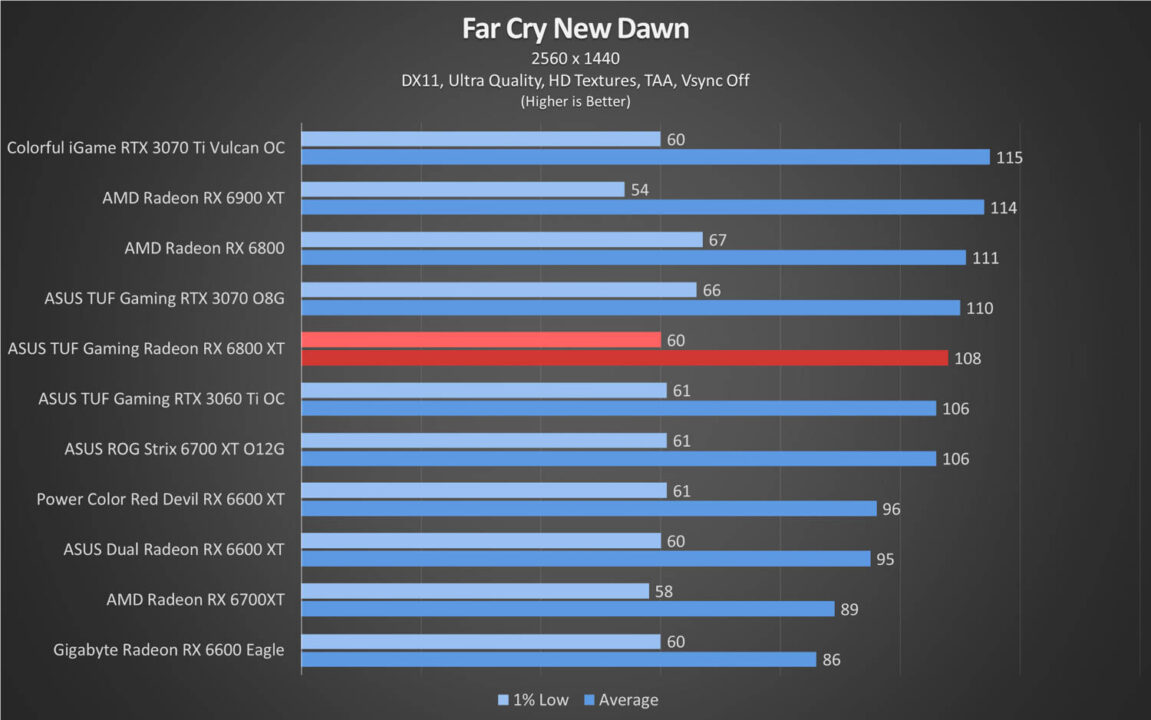
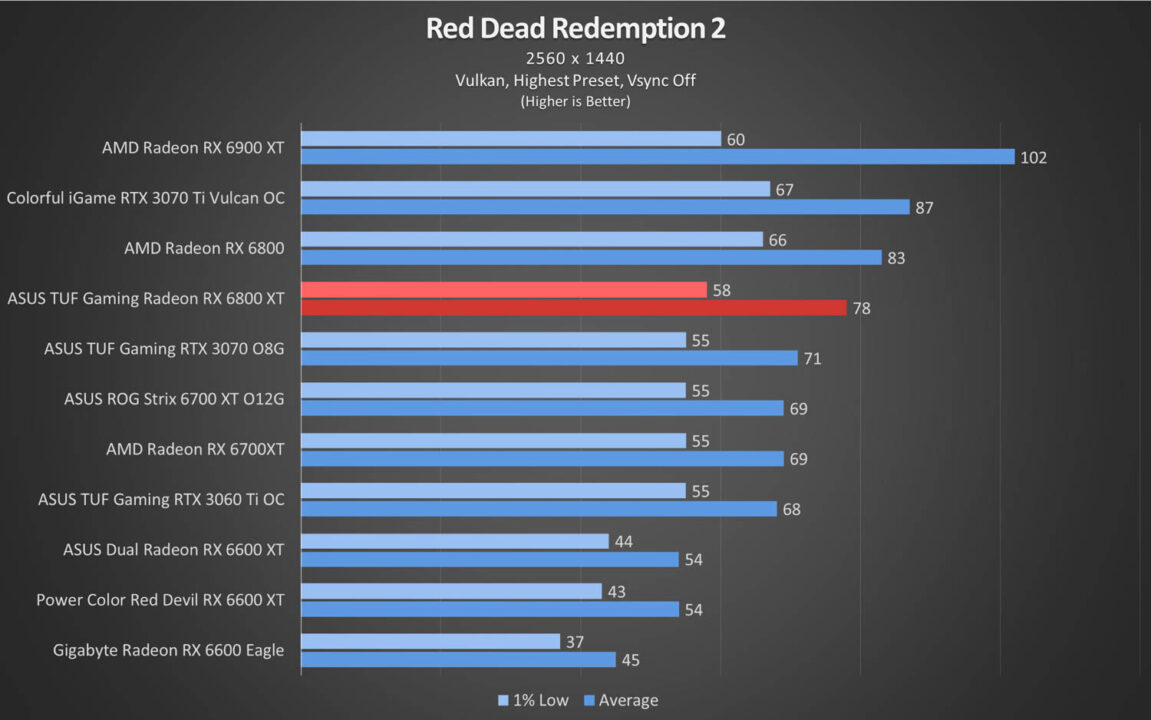
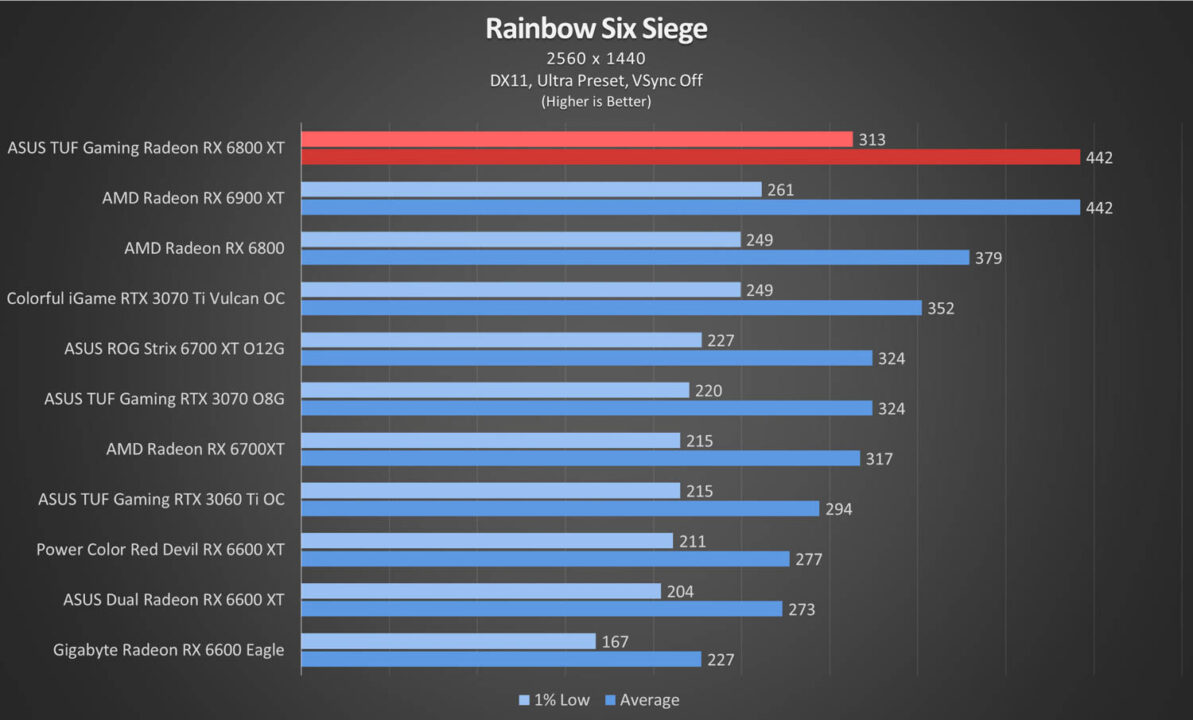

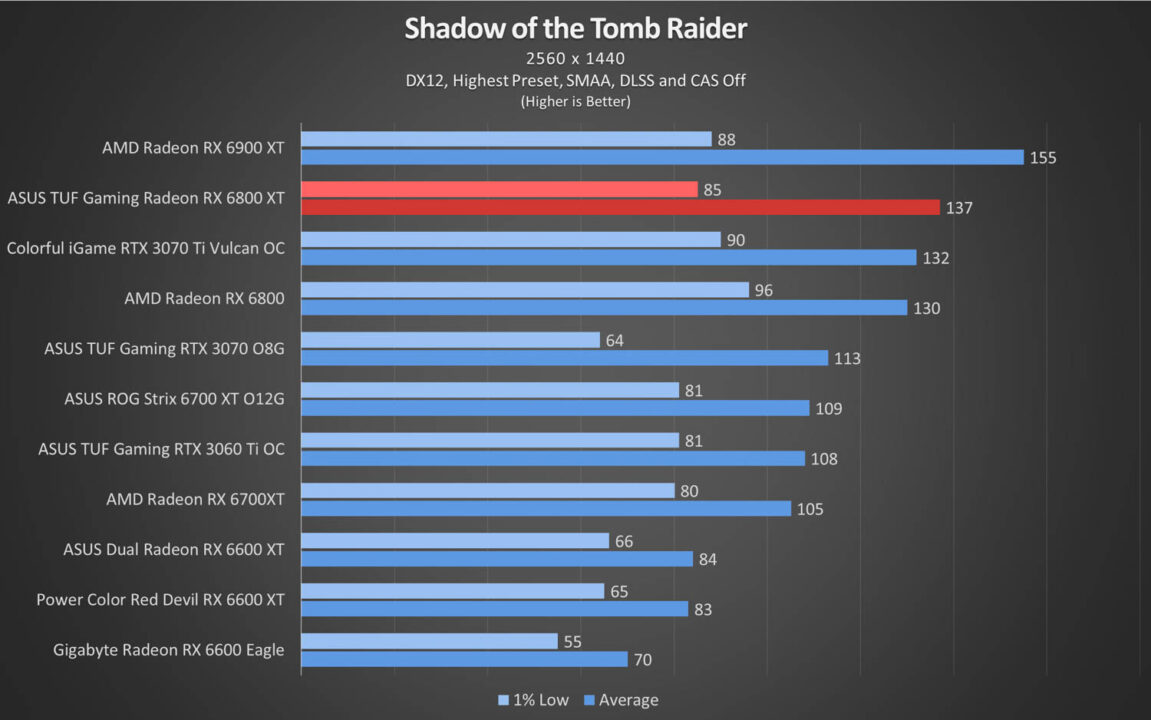

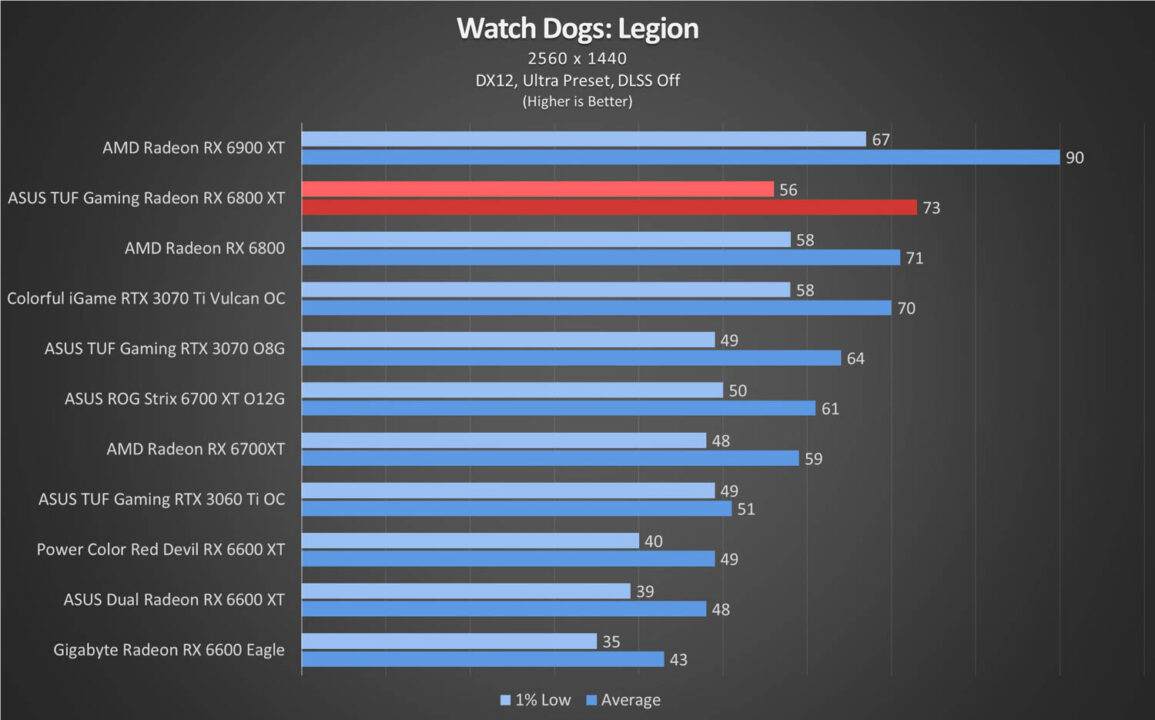
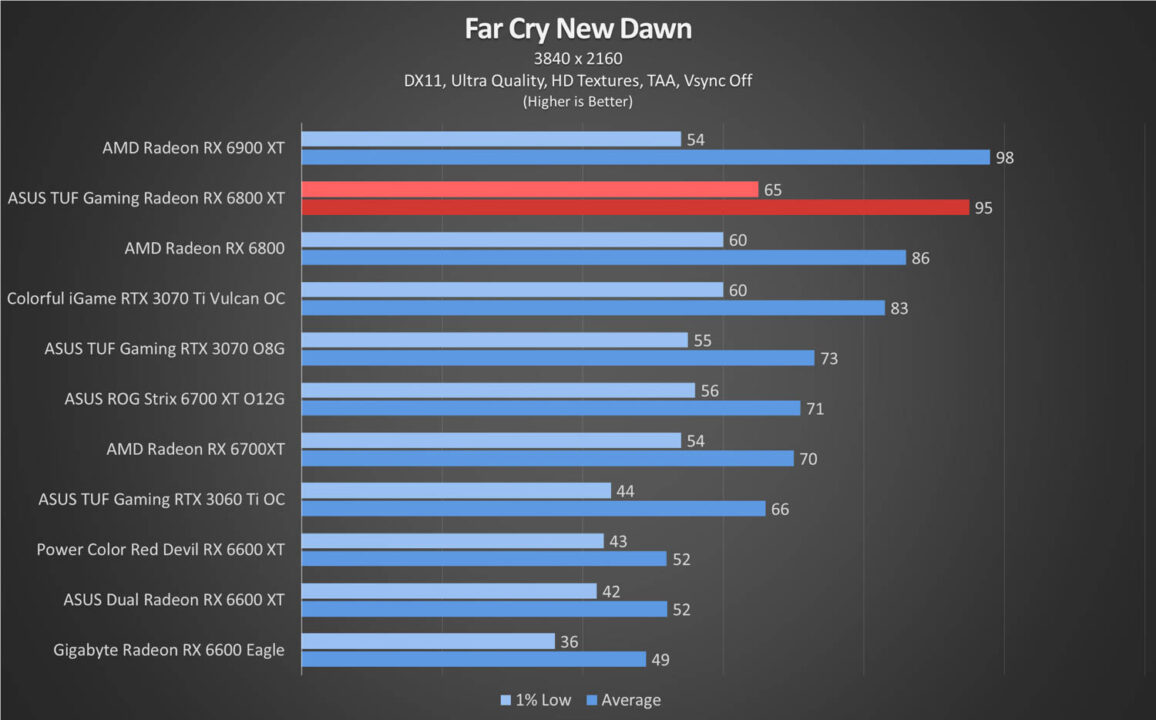

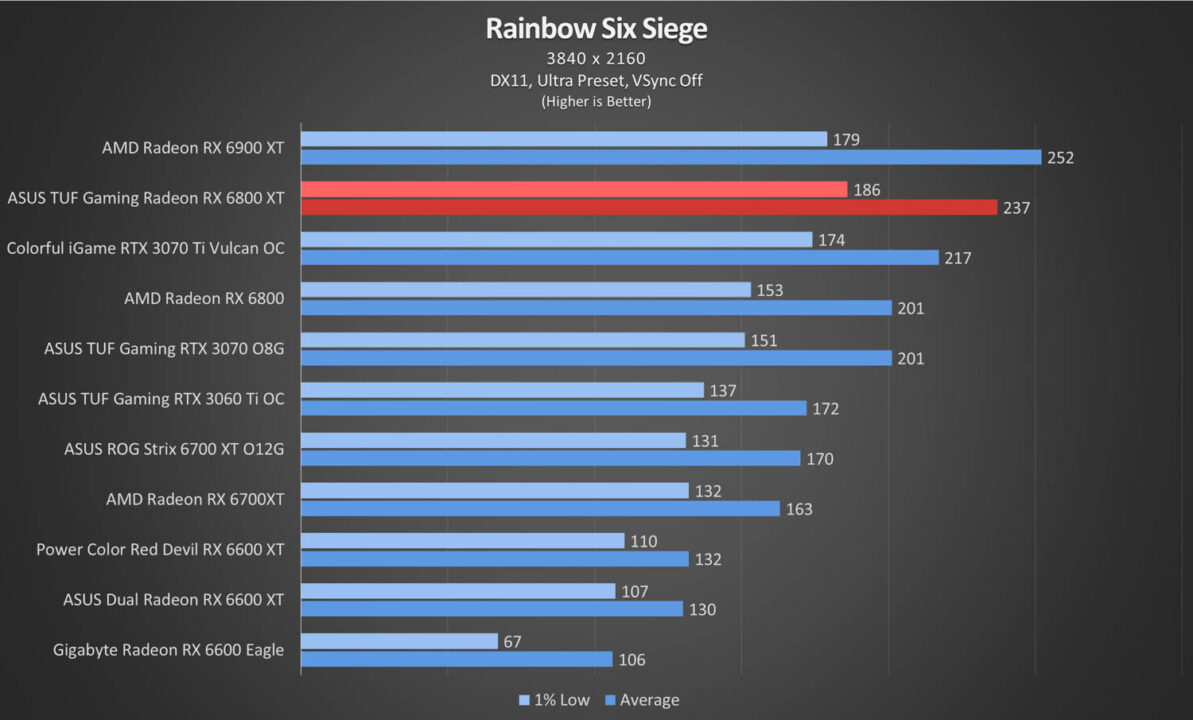
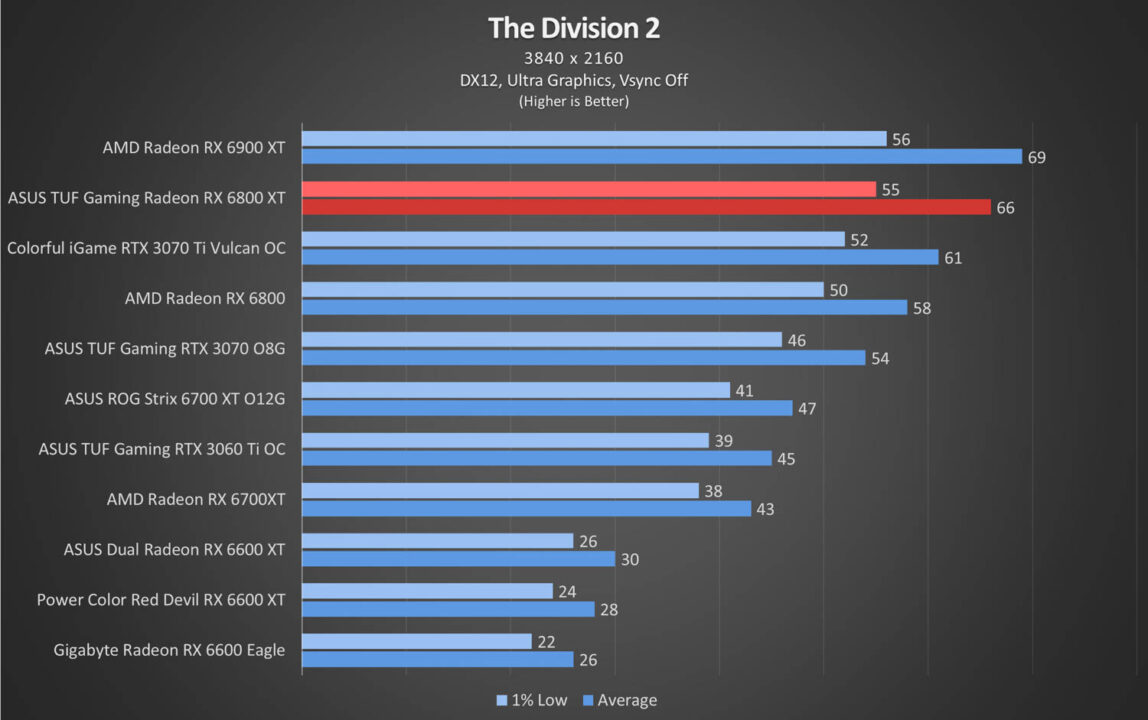
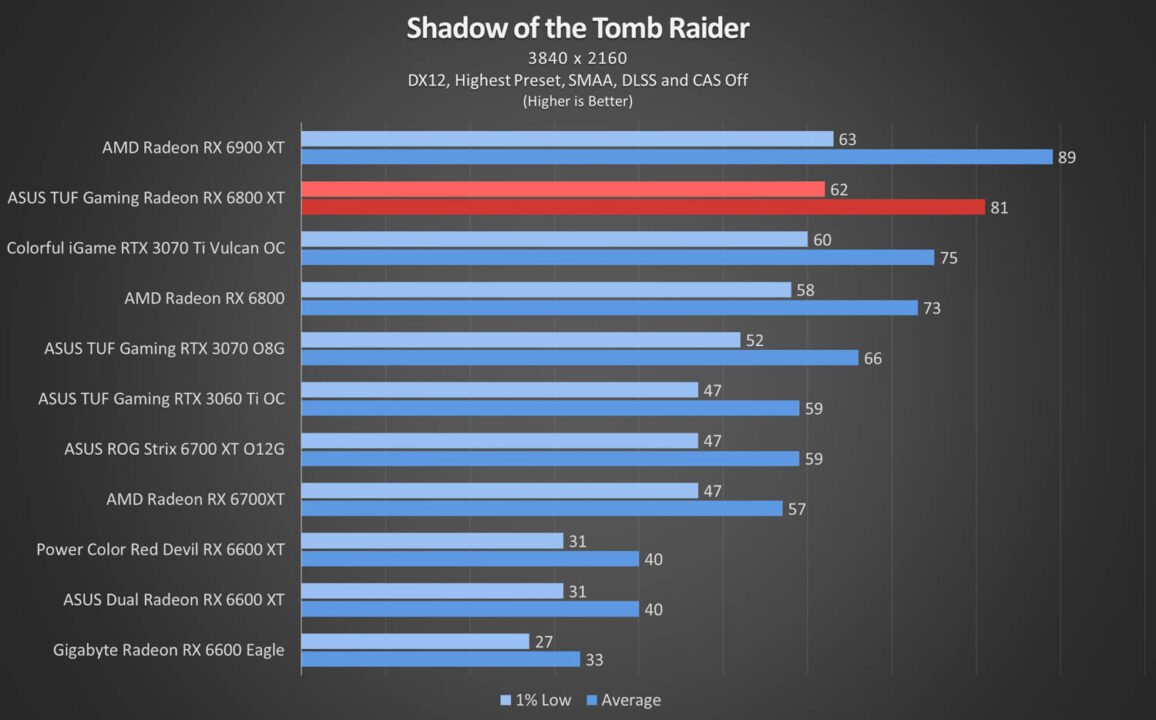
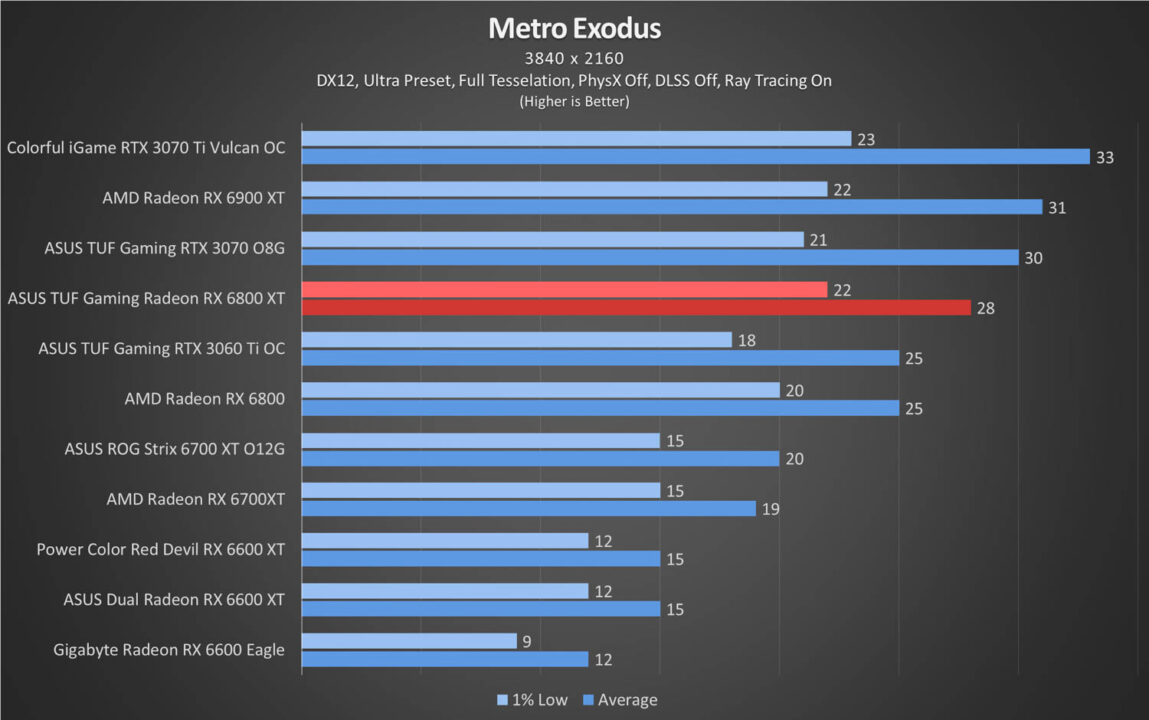
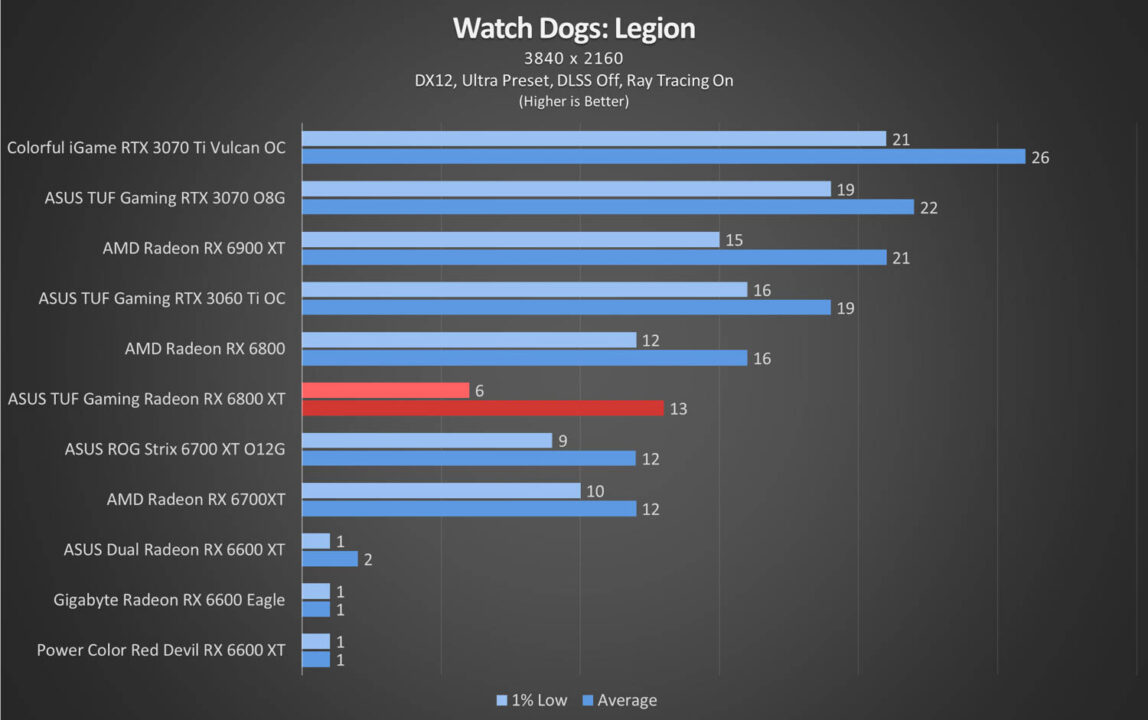
The card pretty much blasts through any game at 1920 x 1080. It can comfortably run graphically-intensive games at more than 60fps on average and some triple A titles can even run at more than 120fps. Competitive games can be easily run on the RX 6800 XT with Rainbow Six Siege running at an average of 530fps when paired with a decent CPU. Fast, exotic displays that can run at more than 240Hz at 1080p can be used comfortably with it.
The RX 6800 XT was designed for 2560 x 1400 and performance shows as such. It will be able to run most games near or at 60fps with additional framerates for faster displays. Again, competitive games will run fast on the card reaching an average of 442fps in Rainbow Six Siege.
At 3840 x 2160, the card starts to struggle a bit but can still provide decent framerates in most titles. 60fps can easily be reached but if the framerates start to chug, some settings will need to be turned down especially settings like anti-aliasing.
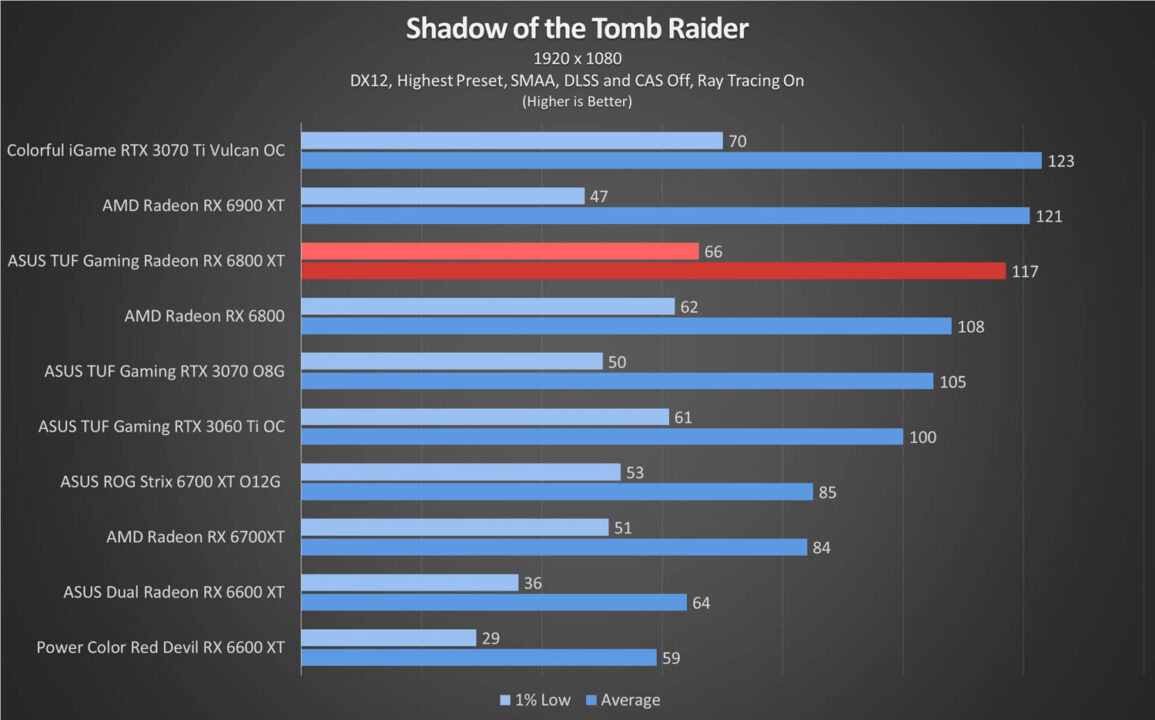

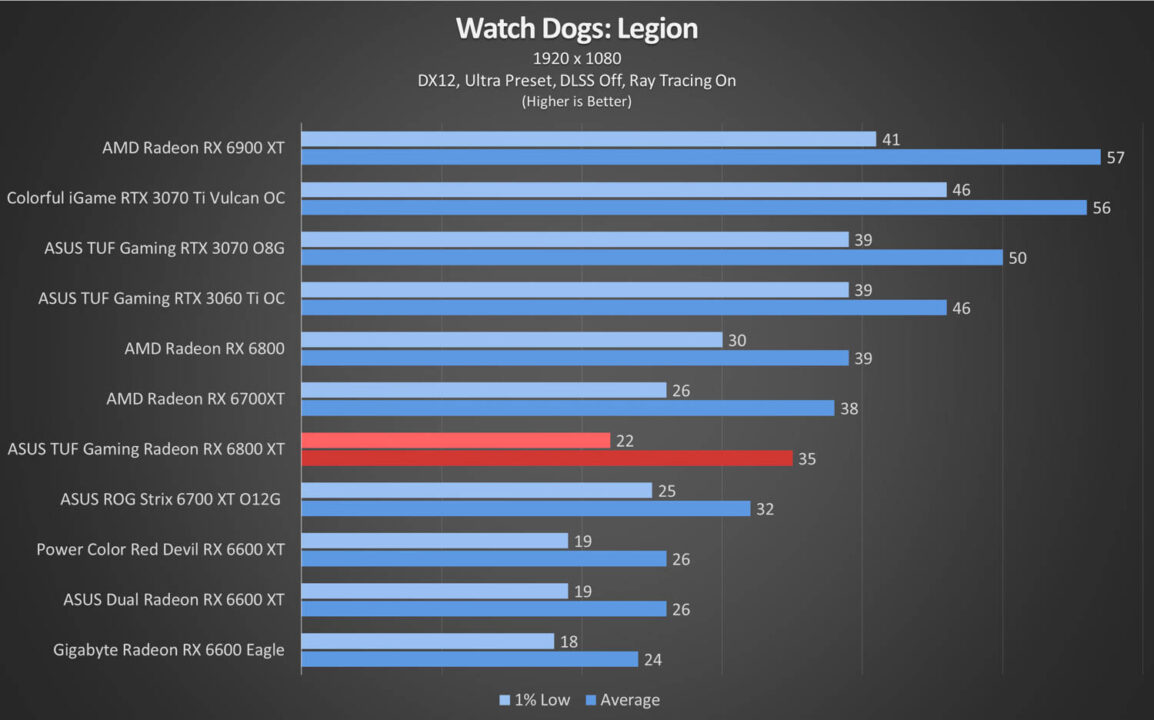
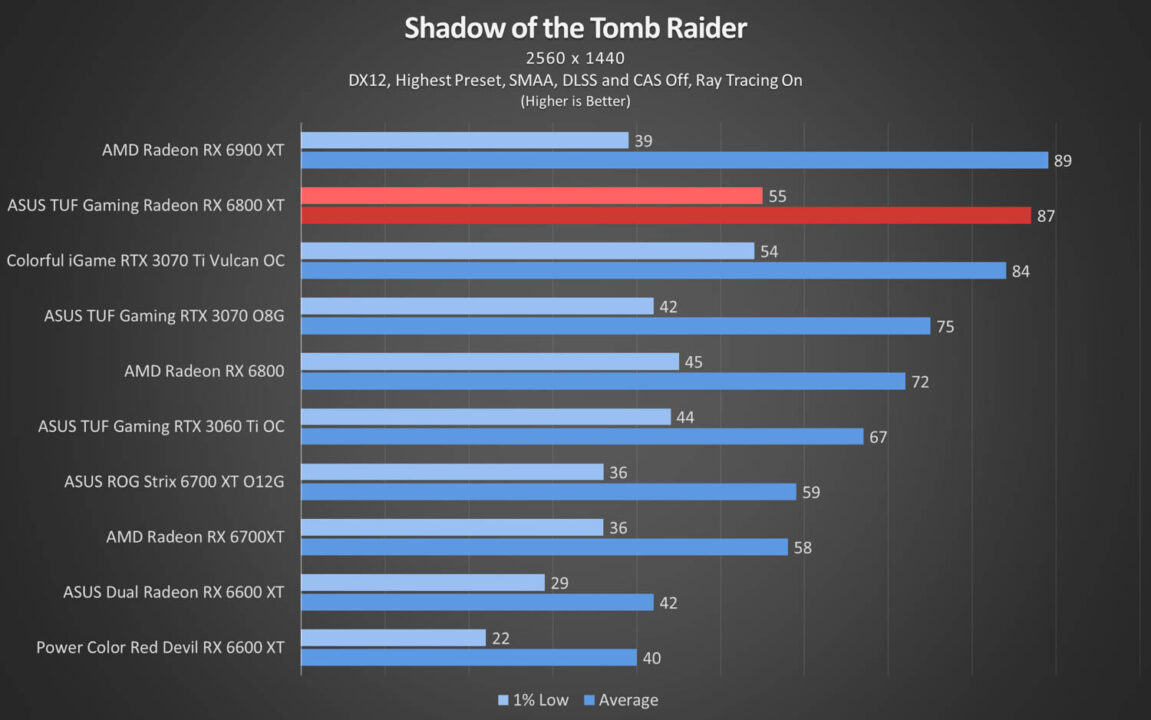
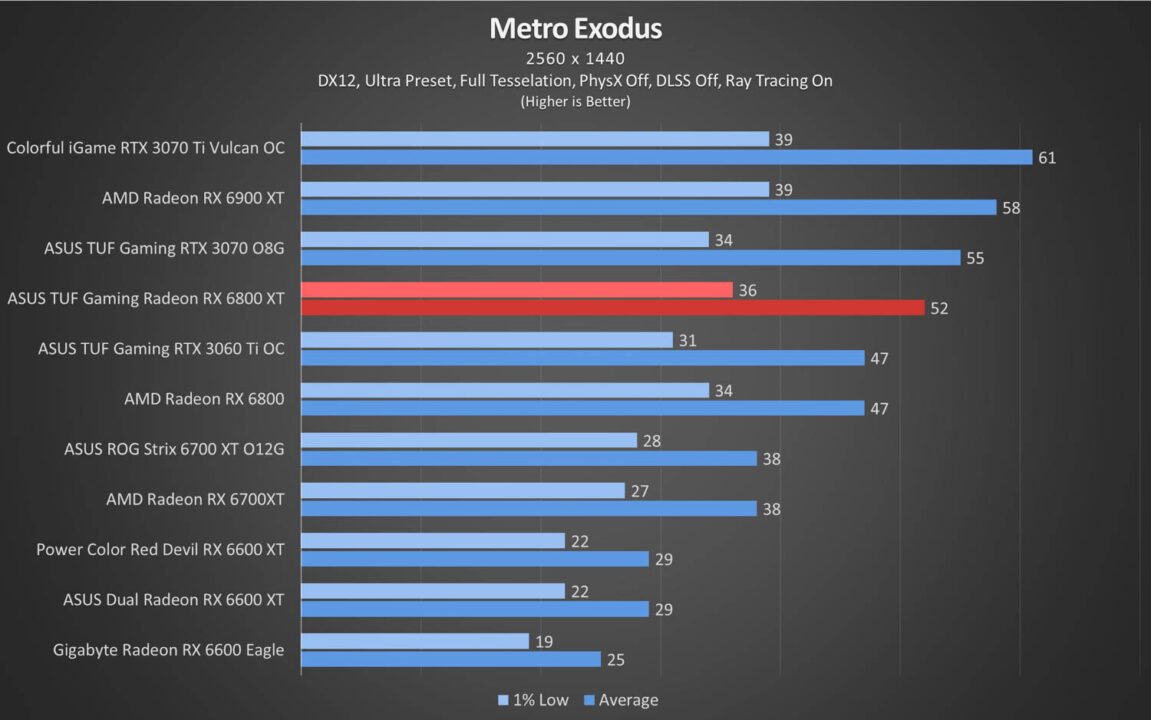
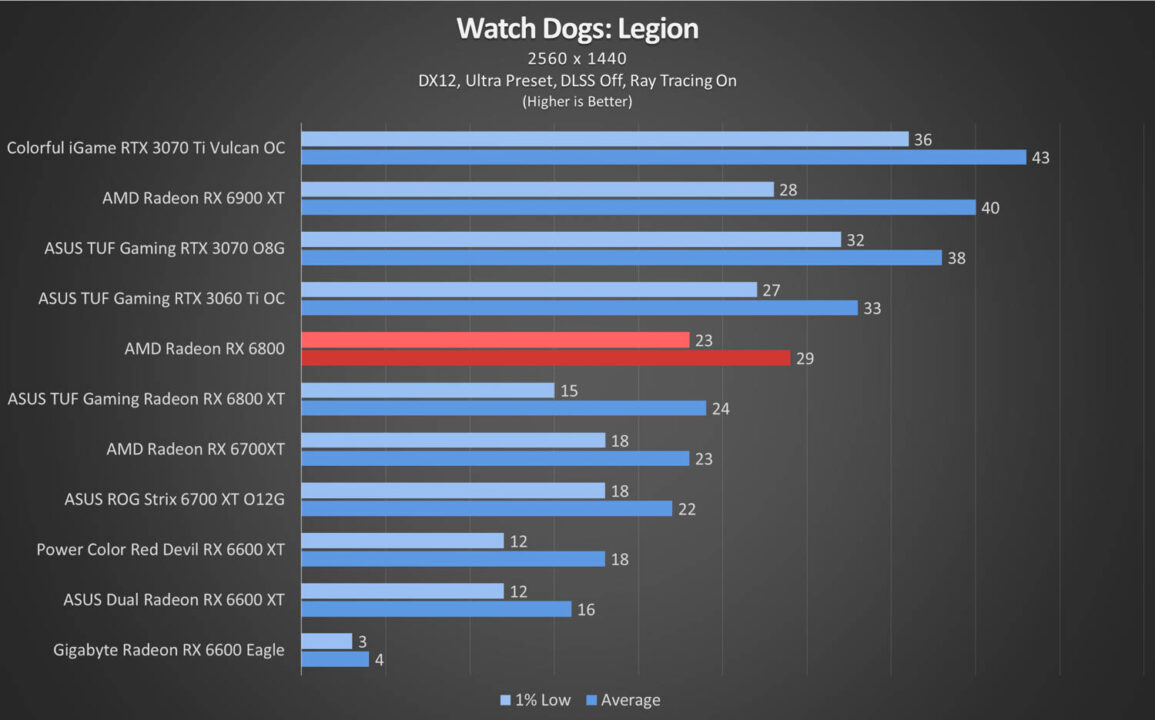

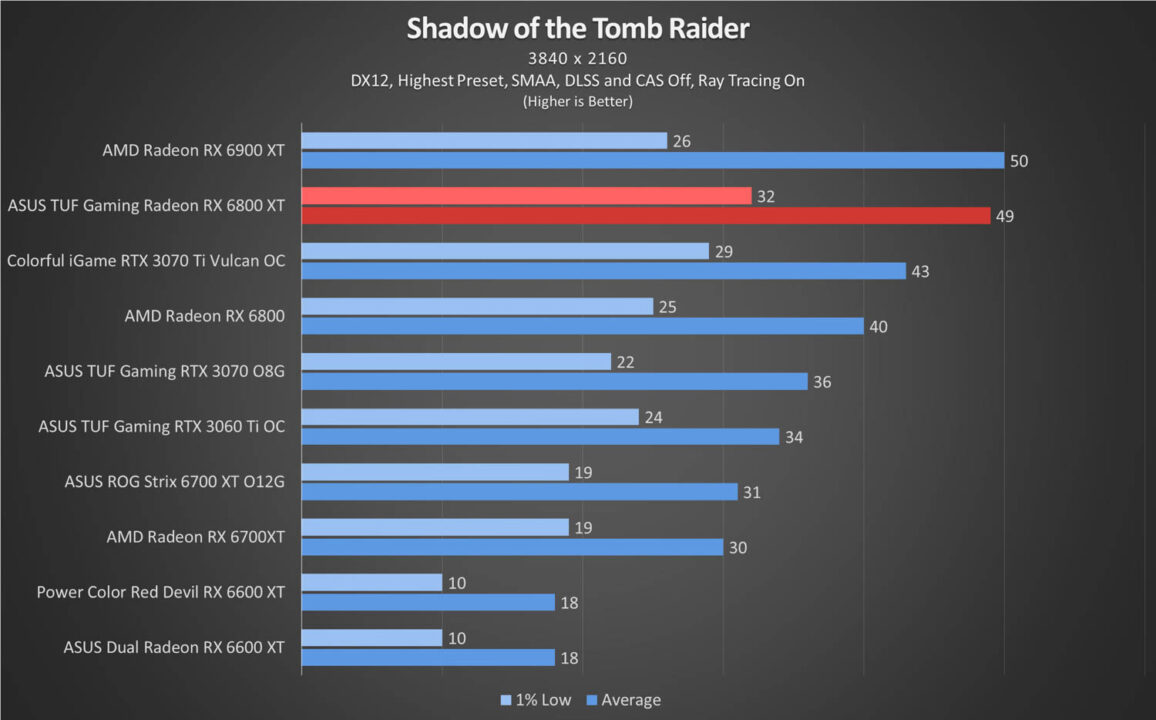
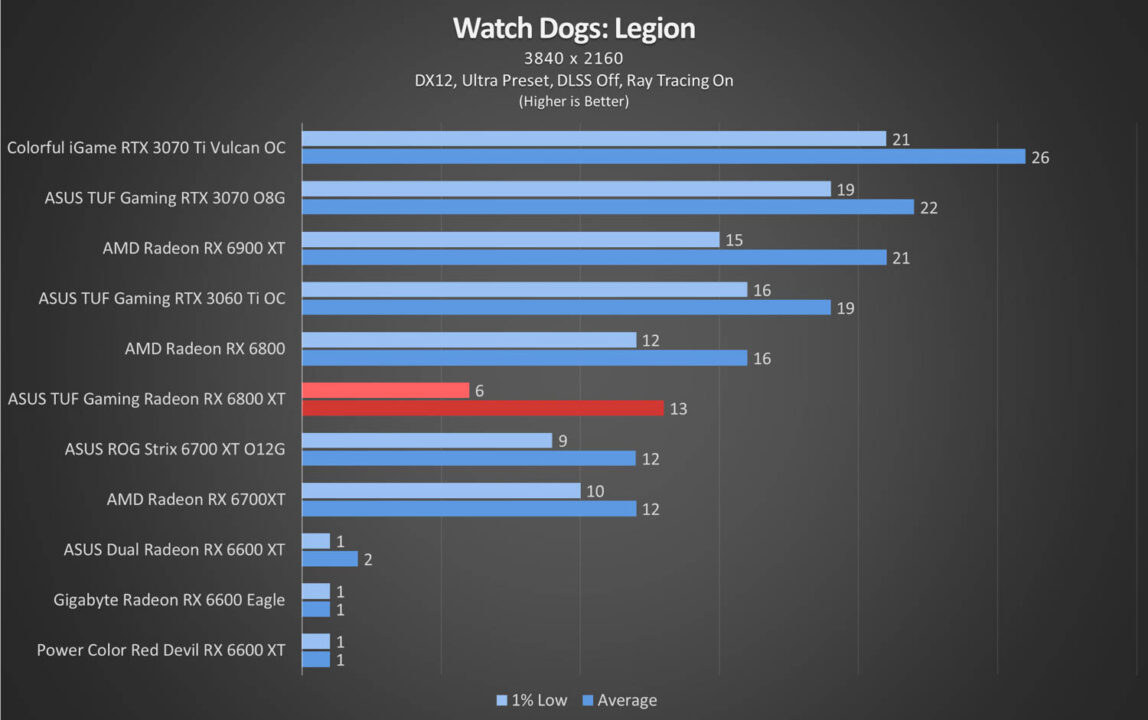
As mentioned, the RX 6000 series are the first batch of GPUs to officially support ray tracing from AMD. Thus, performance is lackluster compared to the current selection of the opposition. It can still run ray tracing effects at high at 1080p but performance quickly takes a significant dip at higher resolutions.

The AMD Radeon RX 6800 XT has a maximum rated TDP of around 300W. Under heavy load, the card will take around 272W of power to run but will sit at idle at near 22W. You should be able to run the card alongside other components with a 650W PSU but 750W unit will give you some headroom just in case.
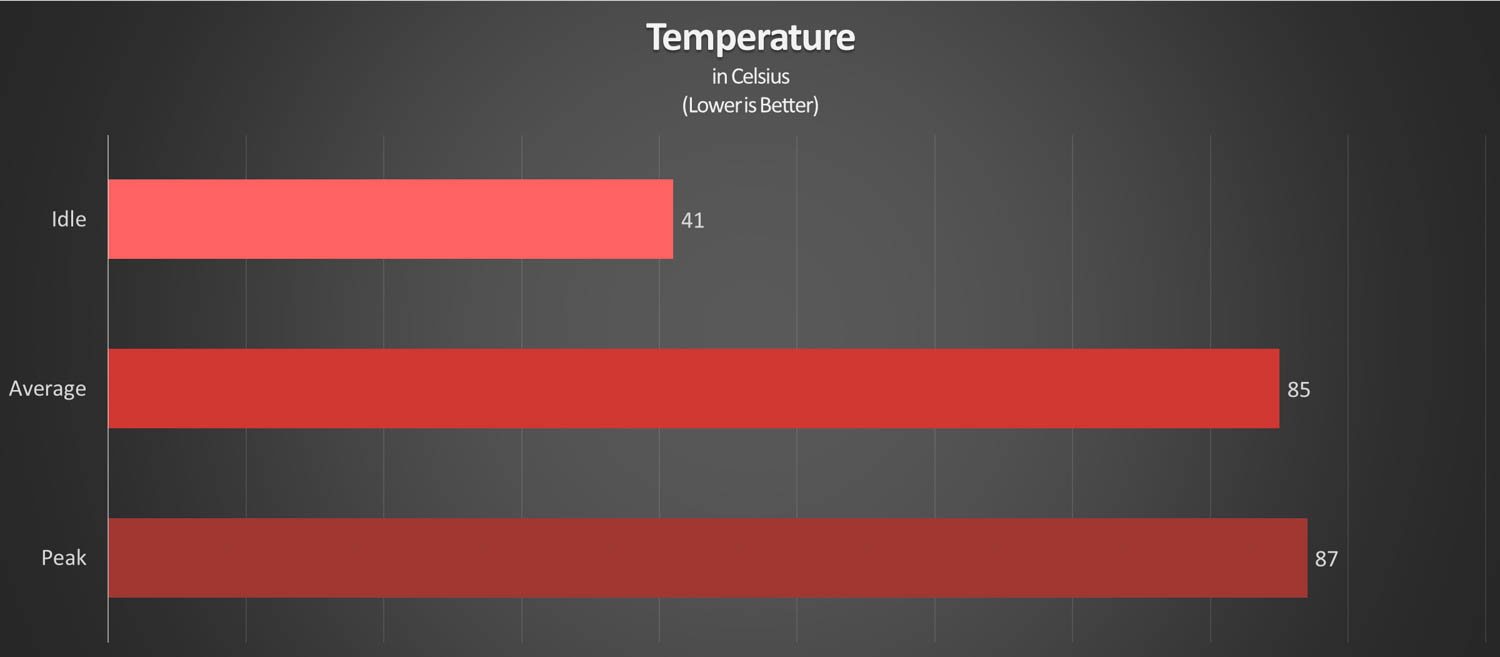
That 272W needs a lot of cooling to keep heat down but fortunately its cooling system is up to the task. Its triple Axial fans do turn off if the card’s temperature is below 60°c and at idle, it sits cool at only 41°c. Fans do ramp up at heavy workloads with the card resting at a relatively comfortable peak of 87°c.

The ASUS TUF Gaming Radeon RX 6800 XT is an excellent take on AMD’s Radeon RX 6800 XT card. It performs admirably in all resolutions regardless if it’s a competitive title of triple A game. Its hefty cooling solution helps to temper down the heat of the RDNA2 GPU to colder levels while still being silent at lower temperatures.
Its big footprint might limit the card to larger builds and will be extremely limited in selections of ITX cases in the market. The RDNA2 architecture also needs some work with the fancier stuff like ray tracing as its current performance in this field is still lacking when compared to its rival.
Overall, the ASUS TUF Gaming Radeon RX 6800 XT is a solid card for gaming regardless of resolution or graphical settings. Though it does have its downsides inherent to the GPU, it will be able to deliver a fast gaming experience when paired with a decent setup; which is why we are giving it our seal of approval.
The ASUS TUF Gaming Radeon RX 6800 XT is now available worldwide with a starting price of USD 579. In the Philippines, you should be able to get the card at around PhP 40,000 depending on the pricing of the retailer.
